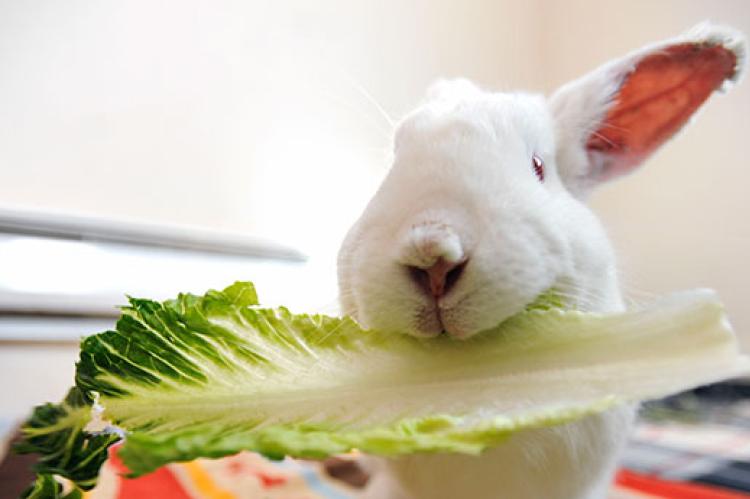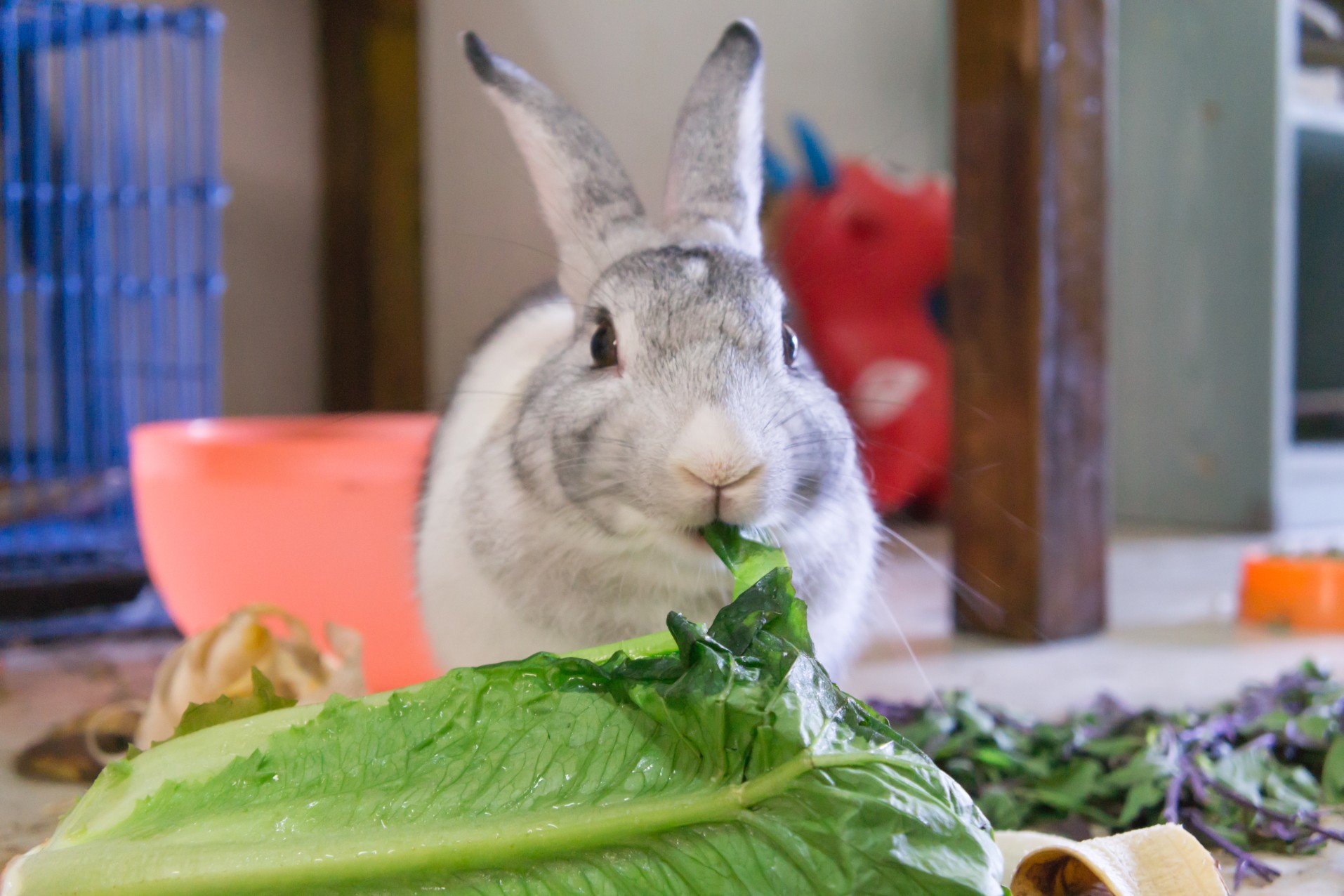Yes, rabbits can eat baby romaine. While it is not one of the most nutritious greens for them, it provides a tasty treat that they can munch on now and then. However, as with any food item, if given in excess or too often, it can cause digestive problems. Therefore, it is best to offer it in moderation and make sure your rabbit also gets a wide variety of other vegetables in its diet for optimal nutrition.
As with any food item, always wash the romaine before giving it to your rabbit. Additionally, make sure that you are monitoring their stools for signs of digestive upset or allergies. If the baby romaine leads to frequent diarrhea or vomiting, it is best to take it away and give them something else instead.

Can rabbits eat mini romaine lettuce?
Yes, rabbits can eat mini romaine lettuce. Mini romaine lettuce provides a fiber-rich crunchy snack for your rabbit and contains important vitamins and minerals that can provide health benefits. Again, however, it should be given in moderation to ensure that your rabbit also gets a variety of other vegetables in its diet for optimal nutrition.
There are a few things you should keep in mind when feeding your rabbit mini romaine lettuce:
- Make sure that the lettuce is thoroughly washed to remove any pesticides or debris.
- Feed only organic, non-GMO varieties of lettuce.
- Lettuce leaves should be no larger than the size of your rabbit’s head.
- Offer small amounts of lettuce to your rabbit every day and monitor how they react to it. If they’re not interested, don’t force them to eat it.
- Shake off any excess water before feeding the lettuce so that it doesn’t get soggy.
- Don’t give your rabbit more than a few leaves of lettuce at one time to avoid digestive upset.
Can bunnies eat romaine lettuce?
Yes, bunnies can eat romaine lettuce. Romaine lettuce is a healthy snack for your bunny and contains essential vitamins and minerals that offer health benefits. However, as with any food item, if given in excess or too often, it can cause digestive problems. Therefore, it is best to offer it in moderation and make sure your bunny also gets a wide variety of other vegetables in its diet for optimal nutrition.
A healthy rabbit diet should consist of hay, fresh vegetables and herbs, a small amount of special dietary pellets, and limited treats. Hay should make up the majority of a rabbit’s diet as it is rich in fiber which helps aid digestion. Fresh vegetables are also important for providing essential vitamins, minerals, and antioxidants. Herbs add to the nutritional value of a diet as well as being tasty for rabbits. Small amounts (1 tablespoon per 5 lbs) of special dietary pellets can provide additional nutrients that may be missing from other food sources. Lastly, treats should only be given sparingly, such as 1-2 teaspoons of fruits or vegetables per day.

How much romaine lettuce can a rabbit eat?
The amount of romaine lettuce a rabbit can eat depends on the size and age of the rabbit. On average, a healthy adult rabbit should be able to consume around one cup of romaine lettuce per day safely. As with any food item, it is best to limit the intake and offer other vegetables as well in order to ensure the bunny is getting a balanced diet. Monitor your pet closely as they may not always be able to digest the lettuce properly, and a veterinarian should address any signs of digestive upset.
Romaine lettuce is an excellent source of vitamins, minerals, fiber and antioxidants for rabbits. It can help boost their immune system and provide essential nutrients that are otherwise lacking in their diets.
Can I give my bunny romaine lettuce every day?
While romaine lettuce can be a beneficial addition to your bunny’s diet once or twice a week, it should not be the only vegetable offered. As with any food item, too much can lead to digestive problems and obesity. It is best to feed your rabbit romaine lettuce in moderation (around one cup per day) and mix up the type of vegetables they eat each day.
Not only that, but you can also treat your rabbit to some leafy greens like dandelion leaves or clover on special occasions. These may contribute to a healthier and happier bunny. Fresh herbs are an awesome addition to their diet too.
Does romaine lettuce contain lactucarium?
Indeed, romaine lettuce does contain lactucarium. This naturally-occurring sedative has been utilized for hundreds of years in herbal medicine and is present within both the leaves and stems of this particular variety – though its concentration tends to be less than that found in other lettuces such as red leaf or butterhead. The presence of this compound often gives the lettuce a slightly bitter flavor which may not suit everyone’s palate.
Romaine lettuce is an excellent source of dietary fiber, essential for maintaining a healthy digestive system. It’s also rich in vitamin K, which helps the body produce clotting agents and keep bones strong. Plus, romaine lettuce contains many vitamins like Vitamin C that improve immunity and help fight against infections.
What parts of romaine lettuce can rabbits eat?
Rabbits can safely eat the entire romaine lettuce plant, including the leaves, stems and roots. It is important to wash the lettuce thoroughly before feeding it to your rabbit to ensure dirt and bacteria are removed.
It is important to remember that a rabbit’s diet should not be based solely on lettuce. While romaine lettuce can be a nutritious supplement to a balanced diet, it should not make up the majority of their meals. Rabbits require much more than just lettuce for proper nutrition and health, such as hay, fresh leaves, and fruits and vegetables. Supplementing their diet with other healthy sources of food will ensure they are getting the nutrients they need.
Can rabbits get E.coli from romaine lettuce?
For years, romaine lettuce grown and harvested commercially in California and Arizona at the end of their respective growing seasons has been linked to numerous outbreaks of infection. To prevent E. coli contamination when washing romaine lettuce, it is important to use plain running water. If you wish to sanitize the lettuce further, you can add a few drops of distilled white vinegar or lemon juice to the water and swish the lettuce around in it for a few seconds. However, these additional cleaning agents have not been proven to be more effective than plain running water and are not recommended.

Can romaine lettuce cause gas in rabbits?
Yes, romaine lettuce can cause excessive bloating and gas in rabbits if it makes up a large portion of their diet. Rabbits should not be fed large amounts of lettuce or other leafy greens as the high water content can lead to digestive problems such as gas. It is important to feed rabbits a well-rounded diet that includes hay, fresh leaves, fruits and vegetables, and only small amounts of lettuce.
Rabbits need to eat hay regularly in order to maintain proper nutrition and prevent issues such as bloating and gas. Hay helps to wear down the ever-growing teeth of rabbits, prevents hairballs from forming in their stomachs, and provides fiber for optimal digestion. Additionally, hay can help stimulate their mental activity, which leads to happier and healthier rabbits. For these reasons, it is important for rabbits to consume plenty of quality hay every day.
Can rabbits eat baby red romaine lettuce?
Although not recommended, baby red romaine lettuce can be served as a rare treat to rabbits – but in small portions. Since the water content of this type is high, it should merely occupy an insignificant portion of their diet. Moreover, ensure that you cleanse the lettuce thoroughly before feeding your rabbit to eliminate any toxins from its surface.
Rabbit owners must be mindful of the amount of lettuce they feed their pets. Excessive consumption can bring about health issues such as bloating, diarrhea, and weight gain. To maintain optimal well-being for your bunny friend, it’s best to provide a balanced diet consisting mainly of hay, vegetables and other properly-selected food items. Before giving any new food item to your rabbit companion, take time to observe them closely so that you can quickly react if they have an adverse reaction or are not handling the change well.
